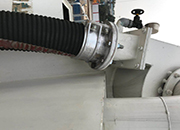What Type of High Pressure Cleaning Hose Should You Buy?
2022-08-18 16:07:32
If you're a professional high-pressure cleaner, you may be wondering what type of hose you should buy. There are a variety of different kinds on the market, but in this article, we'll take a look at two popular choices: resin hose and rubber hose. You'll be able to better understand the differences and choose the right one for you. Read on to learn more!
High pressure cleaning hose
High pressure cleaning hoses can be used for many different purposes, including car washing and house cleaning. They can also be used to transport hydraulic oil and water. While most hoses are made of rubber, some are made of PVC/ABS plastic or polyurethane. Rubber hoses are generally more flexible, but they can fade faster and leave scratches on surfaces. For extra flexibility, polyurethane hoses are made from steel braid and rubber. Although they are more expensive than rubber hoses, they are very cost-effective.
High-pressure water cleaning is a highly effective method of cleaning. It uses water pressures between 34 and 70 MPa to remove grime, loose paint, mold, dust, and other stubborn particles. High-pressure water cleaning is able to clean a variety of surfaces including concrete, brick, tile, and tile. These are some tips to help you get the most out of your high-pressure water cleaning system.
High-pressure cleaning hoses are essential tools for cleaning pressure washers. It helps you achieve deep cleaning of surfaces, while keeping your water tank at a constant level. High-pressure cleaning is not recommended. Hoses are typically attached to high-pressure cleaning guns and high-pressure cleaners. You'll also need a feeding tube, which allows you to connect to a more distant water source without constantly filling it.
High pressure cleaning resin hose
High-pressure cleaning resin hoses are made to withstand high pressure cleaning and other processes. A typical high-pressure cleaning resin-hose has a core of polyvinyl chloride, a plasticizer and a sulfate based coprecipitate stabiliser. It may also include 5% to 15% CHEMIGUM and calcium carbonate, among other materials.
Nylon hose is flexible and easy to install. The fluid flows smoothly through the hose's slippery inner surface. This hose is also low-permeability and easy to maintain. Nylon hoses come in a variety of colors. Depending on the application, they are available in two or three-part constructions. The outer wall is nylon and the inner surface is coated with a thin coating of PVC or nylon.
An adhesive is preferred to attach a braided sheath 16 to the core layer. The compatible adhesive may comprise urethane, polyurethane, or a mixture of urethane and methyl ethyl ketone. The adhesive should be strong enough to hold the sheath together. The bond between the sheath and the core layer is preferably sufficient to prevent the core from separating during the process of cleaning.
High pressure rubber hose for cleaning rubber
High-pressure cleaning rubberhoses are designed to handle high pressures in a variety applications. The hose is made from synthetic rubber with a wire insert to ensure durability. They are resistant to oil, ozone, temperature, and all commercial cleaning detergents. Here are some things to look out for in a high pressure cleaning hose. This article will explain the advantages of rubber high-pressure hoses and how they work.
A high-pressure hose can be used alone or as part of a larger piece of equipment. It is designed to withstand high-pressures and is usually made of stronger materials than its lower-pressure counterparts. It's used in conjunction with a pressure washer, which shoots large amounts of water through the hose at high speeds. High-pressure hoses are also useful for transporting sand or cleaning solvents.
Protective gear is required when operating a high-pressurehose. You can use goggles or gloves to protect your face. The instructions on the hose's manufacturer will provide the best protection for your face and hands. You can also add devices to your equipment that use a high-pressure hose, such as blow-out guards. These guards prevent the hose from leaking or bursts.